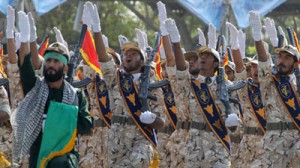 Until recently, the Islamic Republic’s military involvement in Syria was shrouded in mystery. When The Free Syrian Army paraded alleged members of Iran’s Islamic Revolutionary Guards Corps (IRGC) on al-Arabiya this summer, Iranian officials insisted that the abducted men were “pilgrims” and that Iran’s support to Syria was limited to moral backing and economic assistance.
Until recently, the Islamic Republic’s military involvement in Syria was shrouded in mystery. When The Free Syrian Army paraded alleged members of Iran’s Islamic Revolutionary Guards Corps (IRGC) on al-Arabiya this summer, Iranian officials insisted that the abducted men were “pilgrims” and that Iran’s support to Syria was limited to moral backing and economic assistance.
In recent months, however, there has been a shift in Iranian statements. Regime officials have been increasingly categorical in their admissions of Iran’s military presence in Syria, while simultaneously maintaining some ambiguity about the nature of its intervention. Most recently, on September 16, IRGC Commander Mohammad-Ali Aziz Jafari admitted that the IRGC’s Quds Force, which is the extraterritorial operations arm of the IRGC, “are present” in Syria. However, he added that “this does not mean that Iran has a military presence” there and that Iran’s aid was limited to “consultancy and economic assistance.”
Ambiguity may reflect differences over strategy among the Islamic Republic’s ruling elites — and represent a veiled threat that Iran can flex its military muscles even more in Syria. Speaking a day after Jafari’s candid interview, for instance, Foreign Ministry spokesman Ramin Mehmanparast further complicated interpretation of Iran’s messaging by condemning what he called some media outlets’ “selective, incorrect, and politically motivated use” of Jafari’s statements. “Iran has not in any way a military presence in the region, particularly in Syria,” he stressed.
The latest controversy over Jafari’s statement is not the first time that Iran has sent mixed signals about the nature of its involvement in Syria. On May 26, Quds Force deputy commander Brigadier General Esmail Qaani admitted Iranian forces were present in Syria in an attempt to “prevent great massacres” there. Then, on Aug.22, Defense Minister Ahmad Vahidi declared Iran’s readiness to “live up to its defense and security obligations upon Syria’s request,” but he did not concede that Iran maintained any military presence there at the moment.
When it comes to potential differences among Iran’s ruling elites, it is hardly surprising that IRGC officials would openly boast of Iran’s military presence in Syria. The organization has an interest in making its presence known in order to increase its leverage over other branches of the Iranian government. This isn’t the first time we’ve witnessed this phenomenon: In spring 2008, Quds Force commander Major General Qassem Suleimani sent a message to Gen. David Petraeus, then the commander of international forces in Iraq, claiming that he controlled Iranian policy in Iraq, Lebanon, Gaza, and Afghanistan. Suleimani’s message was clear: The United States should negotiate with the Quds Force rather than other branches of the Islamic Republic in order to solve the problems it was facing in the Middle East and Southeast Asia.
Suleimani’s message to Petraeus, of course, was self-serving. If the United States proved willing to engage in negotiations with him, it would further enhance his prestige and the Quds Forces’s control over strategic decision-making in Iran. Similarly, Qaani and Jafari’s admissions of the IRGC’s military presence in Syria is a way of communicating that those who desire a negotiated solution to the crisis in Syria must involve the Quds Force.
The Foreign Ministry, on the other hand, probably opposes Iran’s military involvement in Syria lest it result in the Quds Force taking the lead on Iran’s Syria policy. This may not only explain Mehmanparast stressing that Iran has “no military presence in the region,” but also the Foreign Ministry’s systematic attempts at mediating between the opposition and President Bashar al-Assad’s regime.
The statements of Iranian military involvement can also be interpreted as the IRGC’s way of threatening to increase its intervention, which would transform civil war in Syria into a regional war. The threat obviously aims to force Westerners, Turks, and Saudis to think twice before getting further embroiled in a proxy war. The ploy, however, could be too little, too late: Assad’s regime may be beyond salvation, and increased IRGC presence in Syria is no guarantee for success.
According to the Wall Street Journal, a certain Brigadier General Hossein Hamadani has been sent to Syria to oversee the Quds Force’s operations. It’s not hard to understand why Hamadani would be chosen: According to his official biography Taklif Ast Baradar (“Brother, It’s Duty”), he has extensive experience in suppressing the Kurdish separatist movements in Iranian Kurdistan in the immediate aftermath of the 1979 revolution and during the Iran-Iraq war. In 2005, Jafari, the founding commander of the IRGC Strategic Studies Center, appointed Hamadani his deputy, and together they devised doctrines to counter “velvet revolutions.” In 2009 and 2010, Hamadani managed to effectively suppress anti-regime rallies in Tehran.
Hamadani’s background may be of some help to him today. However, with the protests in Syria having developed into an armed rebellion, and with the rebels gaining access to more sophisticated weaponry, he may find himself fighting a very different war than the one he won against peaceful protesters in the streets of Tehran.
FP

Leave a Reply